 |
 |
 |
| |
IDENTIFYING PATIENTS WITH A HIGH LIKELIHOOD OF ACHIEVING AN SVR FOLLOWING RE-TREATMENT WITH
PEGINTERFERON ALFA-2A (40KD) PLUS RIBAVIRIN: USE OF POSITIVE PROGNOSTIC FACTORS (PPF'S)
|
| |
| |
Pegylated interferon alfa-2a (40KD) plus ribavirin (RBV) in prior ...
Pegasys REPEAT Study: 53-68% SVR with EVR & 72 Weeks duration of therapy
www.natap.org/2007/AASLD/AASLD_38.htm
Presented at the 44th Annual Meeting of the European Association for the Study of the Liver 22-26 April 2009, Copenhagen, Denmark
Reported by Jules Levin
D.M. Jensen,1 A. Craxi,2 C.E. Brandao-Mello,3 A.M. Di Bisceglie,4 P. Andreone,5 B. Freilich,6 K.R. Reddy,7 A. Oliveira,8 G. Teuber,9 D. Messinger,10 J.A. Thommes,11 A. Tietz,12 P. Marcellin13
1Center for Liver Diseases, University of Chicago Hospitals, Chicago, IL, USA; 2Divisione Di Gastroenterologia, Instituto Di Clinica Medica Policlinico, Palermo, Italy; 3University of Rio de Janeiro, Rio de Janeiro, Brazil; 4Saint Louis University Liver Center, Saint Louis University School of Medicine, Saint Louis, MO, USA; 5Department of Internal Medicine and Gastroenterology, University of Bologna, Bologna, Italy; 6Liver and Pancreas Institute of Kansas City, Kansas City, MO, USA; 7Division of Gastroenterology, University of Pennsylvania, Philadelphia, PA, USA; 8Hospital La Paz, Madrid, Spain; 9Department of Internal Medicine,
J.W. Goethe University Hospital, Frankfurt, Germany; 10Biometrics, IST GmbH, Mannheim, Germany; 11Roche, Nutley, NJ, USA; 12Roche, Basel, Switzerland; 13Service d'Hepatologie and Centre de Recherches Biologiques Bichat Beaujon (Inserm CRB3), H˘pital Beaujon, Clichy, France
Disclosure information: This research is sponsored by Roche, Basel, Switzerland
OBJECTIVES
We explored whether easily identifiable pretreatment prognostic factors could be used to optimise the prediction of achieving an SVR with peginterferon alfa-2a (40KD) and ribavirin in non-responders to prior pegylated interferon alfa-2b (12KD) plus ribavirin.
"We showed that patients with higher PPF scores were more likely to achieve cEVR and an SVR than patients with a lower PPF score, particularly with 72 weeks of treatment. In particular, patients with a high PPF score benefitted most from a treatment duration of 72 weeks. Physicians can use this scoring system to identify patients most likely to respond to treatment and thus motivate patients for re-treatment with peginterferon alfa-2a (40KD) plus ribavirin."
"Positive prognostic factors (PPFs) included baseline HCV RNA <800 000
IU/mL, age ≥45 years, body weight <75 kg, absence of cirrhosis on liver biopsy and non-genotype 1 infection."
"The PPV of a cEVR for achieving an SVR increased with higher PPF scores in the combined 72 week treatment arms. Almost two-thirds of patients (64.9%) with a cEVR and ≦4 PPFs achieved an SVR (Figure 4A)". 54.7% with PPF 2-3 and cEVR, 37.5% with 0-1 PPF and cEVR.
"The NPV of not achieving a cEVR, and therefore not achieving an SVR, in the combined 72 week treatment arms was high irrespective of the PPF score (Figure 4B)."
Introduction
Pegylated interferon plus ribavirin is the standard of care for the management of patients with chronic hepatitis C virus (HCV) infection.[1,2] The chance of a patient achieving a sustained virological response (SVR) with pegylated interferon plus ribavirin varies according to a suite of well-established baseline characteristics and on-treatment factors. Unfavourable factors include advanced hepatic fibrosis (cirrhosis), infection with HCV genotype 1 and a slow or incomplete virological response to therapy (failure to achieve undetectable HCV RNA [<50 IU/mL] by week 12 of treatment).
Approximately one-half of all patients infected with genotype 1 and 20-30% of genotype 2- or 3-infected individuals fail to achieve an SVR with a first course of pegylated interferon plus ribavirin.[3-7] Re-treatment can be successful in these individuals; however, prior non-responders to pegylated interferon and ribavirin, the standard of care, are the most difficult to cure. SVR rates are reported to be low when these patients are re-treated with 48 weeks of either peginterferon alfa-2a (40KD) (PEGASYS®) [8] or pegylated interferon alfa-2b (12KD) plus ribavirin.[9]
The REtreatment with PEgasys in pATients not responding to prior peginterferon alfa-2b (12KD)/ribavirin combination therapy (REPEAT) study, a Phase III, randomised, multinational clinical trial, explored longer duration of treatment and induction dosing of peginterferon alfa-2a (40KD) plus ribavirin for the re-treatment of non-responders to prior pegylated interferon alfa-2b (12KD).[8] Induction dosing conferred no benefit in REPEAT, but extending the treatment duration to 72 weeks doubled the SVR rate (16% vs 8% with the standard 48-week duration of treatment; RR 2.00; 95% CI 1.32-3.02, p<0.001).[8] An important finding in REPEAT was that 57% of patients with undetectable HCV RNA at week 12 achieved an SVR in the extended treatment arms. This suggests that it is possible to identify patients most likely to achieve an SVR before treatment.
AUTHOR CONCLUSIONS
We used a simple scoring system combining five easy to assess baseline prognostic factors to predict the chance of achieving an SVR with peginterferon alfa-2a (40KD) plus ribavirin in non-responders to prior pegylated interferon alfa-2b (12KD) plus ribavirin therapy.
We showed that patients with higher PPF scores were more likely to achieve cEVR and an SVR than patients with a lower PPF score, particularly with 72 weeks of treatment. In particular, patients with a high PPF score benefitted most from a treatment duration of 72 weeks.
PPF scoring is a simple way to identify patients with a higher chance of achieving an SVR with peginterferon alfa-2a (40KD) plus ribavirin re-treatment for 72 weeks. Physicians can use this scoring system to identify patients most likely to respond to treatment and thus motivate patients for re-treatment with peginterferon alfa-2a (40KD) plus ribavirin.
Furthermore, patients with an undetectable HCV RNA at week 12 have a high chance of achieving an SVR, even for those with a lower number of PPFs. Patients who achieve an undetectable HCV RNA by week 12 of re-treatment should be encouraged to remain on treatment with peginterferon alfa-2a (40KD) plus ribavirin for the full 72-week course of
treatment.
METHODS
Patients and treatment
Patients eligible for REPEAT had not responded to at least 12 weeks of treatment with prior pegylated interferon alfa-2b (12KD) plus ribavirin.
Patients were randomised to one of four treatment arms and re-treated for
72 weeks (arms A and C) or 48 weeks (arms B and D) with peginterferon
alfa-2a (40KD) and standard doses of ribavirin (1000/1200 mg/day) as
shown in Figure 1.
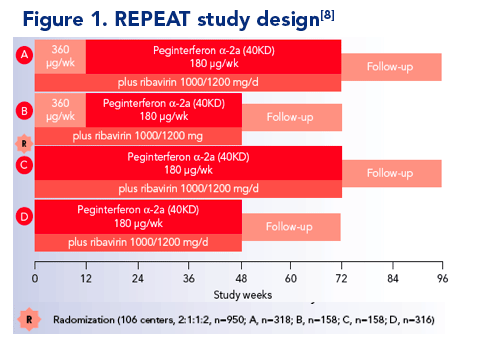
The selected baseline prognostic factors were HCV RNA viral load, age, body weight, histological diagnosis and HCV genotype.
- Each factor was dichotomised based on the likelihood of achieving
an SVR. ROC analyses were used to estimate the optimal cut-off for age
(approximately 45 years) and weight (approximately 75 kg), whereas
well-accepted criteria were selected for HCV RNA level (<800 000 vs
≦800 000 IU/mL), histological diagnosis (cirrhosis, defined as METAVIR
F3 or F4 vs no cirrhosis) and genotype (1 vs non-1).
Outcomes
The primary efficacy outcome was SVR, defined as undetectable HCV RNA (<50 IU/mL) after 24 weeks of untreated follow-up.
Complete early virological response (cEVR) was defined as undetectable HCV RNA (<50 IU/mL) at week 12.
Positive prognostic factors (PPFs) included baseline HCV RNA <800 000
IU/mL, age ≥45 years, body weight <75 kg, absence of cirrhosis on liver biopsy and non-genotype 1 infection.
The impact of each individual PPF on SVR was analysed by multiple logistic regression and based on the regression parameters and odds-ratios rated as strong (2) or weak (1) (Table 1).
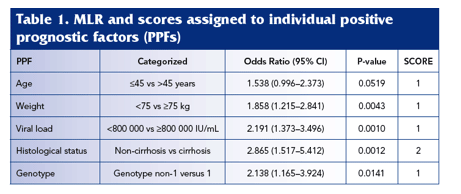
Patients were grouped according to their total PPF score, and SVR rates were calculated for each subgroup.
We also calculated the positive predictive value (PPV) and negative predictive value (NPV) of achieving/not achieving a cEVR for SVR by the number of PPFs.
RESULTS
Overall, 900 patients with complete data regarding the above factors were included in this study and assigned to one of three subgroups according to low (0-1), intermediate (2-3) or high (≦4) PPF scores. PPF scores were generally evenly distributed across treatment arms (Table 2).
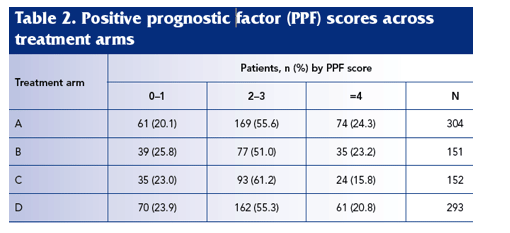
A = Peginterferon alfa-2a 360/180 µg/week for 72 weeks;
B = Peginterferon alfa-2a 360/180 µg/week for 48 weeks;
C = Peginterferon alfa-2a 180 µg/week for 72 weeks;
D = Peginterferon alfa-2a 180 µg/week for 72 weeks
Across all treatment arms, higher PPF scores were associated with
increased cEVR rates (Figure 2).
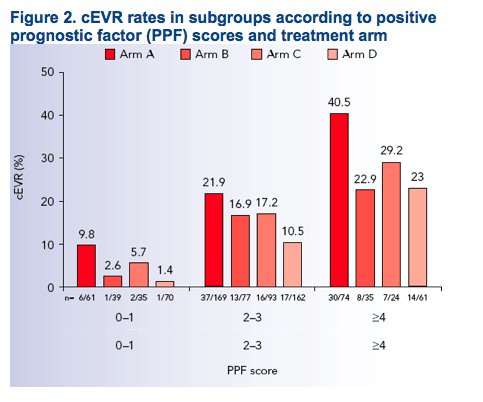
Patients with low PPF scores had correspondingly low SVR rates irrespective of treatment arm (<5%). For patients with intermediate PPF scores the overall SVR rate was 7-8% with 48 weeks of treatment and 14% with 72 weeks of treatment. Among patients with high PPF scores the SVR rate was considerably higher, especially among those treated for 72 weeks (33-35%) (Figure 3).
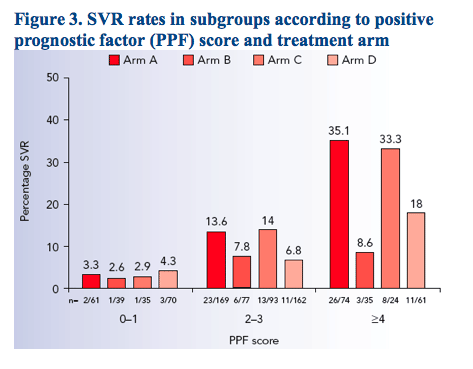
The PPV of a cEVR for achieving an SVR increased with higher PPF scores in the combined 72 week treatment arms. Almost two-thirds of patients (64.9%) with a cEVR and ≦4 PPFs achieved an SVR (Figure 4A).
The NPV of not achieving a cEVR, and therefore not achieving an SVR, in the combined 72 week treatment arms was high irrespective of the PPF score (Figure 4B).
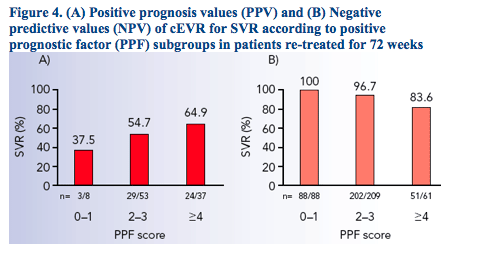
REFERENCES
1. Strader DB, Wright T, Thomas DL, et al. Diagnosis, management, and treatment of hepatitis C. Hepatology 2004; 39:1147-1171.
2. Dienstag JL, McHutchison JG. American Gastroenterological Association technical review on the management of hepatitis C. Gastroenterology 2006; 130:231-264.
3. Manns MP, McHutchison JG, Gordon SC, et al. Peginterferon alfa-2b plus ribavirin compared with interferon alfa-2b plus ribavirin for initial treatment of chronic hepatitis C: a randomised trial. Lancet 2001; 358:958-965.
4. Fried MW, Shiffman ML, Reddy KR, et al. Peginterferon alfa-2a plus ribavirin for chronic hepatitis C virus infection. N Engl J Med 2002; 347:975-982.
5. Hadziyannis SJ, Sette H, Jr., Morgan TR, et al. Peginterferon-alpha2a and ribavirin combination therapy in chronic hepatitis C: a randomized study of treatment duration and ribavirin dose. Ann Intern Med 2004; 140:346-355.
6. Zeuzem S, Pawlotsky JM, Lukasiewicz E, et al. International, multicenter, randomized, controlled study comparing dynamically individualized versus standard treatment in patients with chronic hepatitis C. J Hepatol 2005; 43:250-257.
7. Shiffman ML, Suter F, Bacon BR, et al. Peginterferon alfa-2a and ribavirin for 16 or 24 weeks in HCV genotype 2 or 3. N Engl J Med 2007; 357:124-134.
8. Jensen DM, Marcellin P, Freilich B, et al. Re-treatment of chronic hepatitis C non-responders to peginterferon alfa-2b: a randomized trial. Annals Int Med 2009;150 (8):in press.
9. Poynard T, Colombo M, Bruix J, et al. Peginterferon alfa-2b and Ribavirin: Effective in Patients With Hepatitis C Who Failed Interferon-alfa/Ribavirin Therapy. Gastroenterology 2009; Jan 22 (e-pub ahead of print).
|
| |
|
 |
 |
|
|